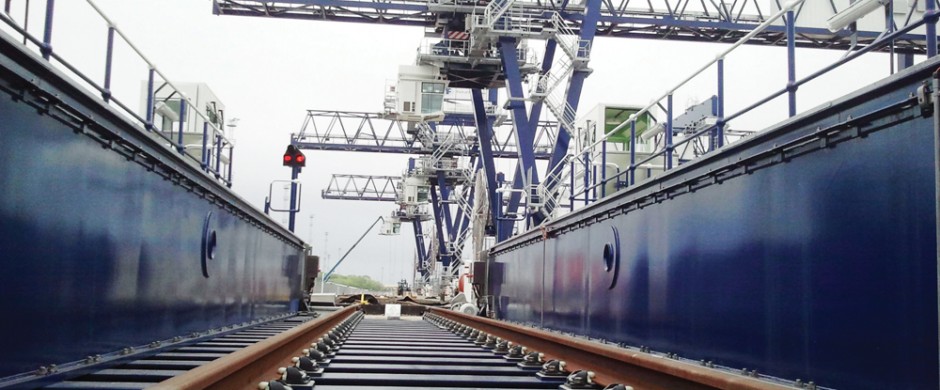Rail freight is on the up. The statistics may get overshadowed by those for passenger train journeys, but they are impressive. Statistics published by Freight On Rail, the industry partnership which promotes the shift to rail freight, make interesting reading.
These include the fact that the rail freight industry has achieved a 48% growth in tonne kilometres since 1994/95 with half the number of locomotives and two thirds of the wagons employed at that time. In the latest reported year alone, from 2010-11 to 2011-12, the amount of freight moved increased by 10%.
All this freight has to come from and go to somewhere. In many cases, that is one of Britain’s container ports, of which Felixstowe is the biggest. Thirty shipping companies operate from Felixstowe and the port welcomes over 4,000 ships a year. In terms of containers, last year the port handled over 3.4million TEUs (Twenty-foot Equivalent Units) – that’s a lot of containers.
New North Rail Terminal
Small wonder, then, that Felixstowe has good rail connections. However, even two rail terminals and over fifty rail movements a day (25 trains in and 25 out) was not enough. So, owner Hutchison Ports has invested £40 million in a new North Rail Terminal and other improvements including ten kilometres of new railway. This provides nine new freight roads bringing the total on site to twenty.
VolkerFitzpatrick was contracted to undertake the construction of the 730-metre long terminal which included a novel feature – a 30 metre long traverser. Using this, locomotives could be uncoupled from their trains, traversed sideways to a run-around road, and then run back to the other end of the next consignment of loaded wagons. It would save a lot of shunting and space.
Designed to handle loads of up to 170 tonnes (current freight locos are around 130 tonnes so the specification included a degree of future-proofing), there was nothing like it in the UK so VolkerFitzpatrick turned to Sheffield-based handling specialists Mechan which had built traversers before, but nothing on this scale.
A question of size
At 30 metres long and weighing 90 tonnes, Mechan’s factory wasn’t even large enough to assemble the behemoth. So a temporary unit was rented 12 miles away which had the necessary space and overhead craneage.
Design and manufacture took a year.
Then the next problem was how to get the enormous construction to the docks. It wouldn’t fit on a train, so the only solution was to take it by road, in one piece, down the A14. Leicester Heavy Haulage, based not far from The Rail Engineer in Coalville, was asked to undertake the tricky task.
With detailed advance planning, the 200 mile trip took two days with only one overnight stop. Mechan engineers then had to lift the traverser into position, VolkerFitzpatrick had already prepared the pit and track, and commission it. The Felixstowe maintenance team, 60 engineers split over three shifts, also had to be instructed how to operate and maintain it.
Reflecting on the project, Mechan’s engineering director Martin Berry said: “Installation of this traverser was a real landmark occasion for us. It has been such a huge undertaking, not only because of its size, but also in terms of the technological developments within its design.”
Still more growth
Following test running, the transverser was ready for the grand opening of the new terminal by the Duke of York in June. Since then, demand has increased still further and there are now a total of sixty train movements (thirty train arrivals and departures) a day. Freightliner is the major operator at Felixstowe, with around two- thirds of the train activity. GB Railfreight operates most of the rest with DB Schenker currently only running a couple of trains a day. So the traverser is already earning its keep.
The new terminal complements work by Network Rail on the Strategic Freight Network. The Ipswich cord, which will open in April 2014, will allow trains to run directly to the North East. At the same time, that North East route will become gauge cleared for 9’ 6” containers to Doncaster and Leeds. This will make the onward movement of freight even easier, and no doubt encourage even more growth in this sector.
Clemence Cheng, chief executive officer of Hutchison Ports (UK) Limited, owner of the Port of Felixstowe, is certainly pleased with the improvements:
“Rail is becoming the mode of choice for an increasing number of shipping lines, forwarders and shippers to move their goods to and from ports. It provides cost, environmental and reliability benefits for many customers and the Port of Felixstowe offers more rail services, to more destinations, more often than any other UK port.
“The new North Rail Terminal will increase still further our rail capability. By allowing us to run longer trains, as well as more of them, it will allow users of the port to improve the efficiency of their supply chains and at the same time reducing cost for them.”



![IMG_6615 [online]](http://railengineer.uk/wp-content/uploads/IMG_6615-online-940x390.jpg)
Clever move!